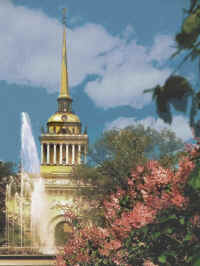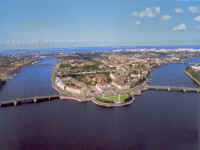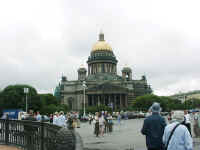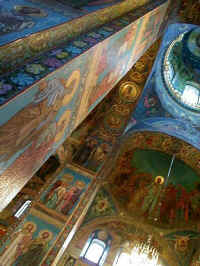 Monday, 22 July. Earlier this morning our boat had entered the Neva River and was now approaching St. Petersburg. We had breakfast at 7:00 so we'd be ready for the city tour scheduled to depart at 8:30. The Tolstoy wasn't able to dock until almost 9:00, however, because there was no space available at the River Terminal. There are only five berths along the shore, and the river boats are moored three deep, accommodating a maximum of 15 boats. We had to wait until one of those 15 left before we could dock. It was an overcast day in the low 70s when we finally started the city tour. The guide told us to be thankful that it wasn't rainy because many summer days were. She added that St. Petersburg has only about 60 cloudless days a year; the river is usually frozen over for eight months; and there is frost from late August until early May. We were duly thankful. Besides, we preferred this weather to the 90 degree temperatures that had greeted us in Moscow. Beginning in 1703 with the construction of the Peter and Paul Fortress, St. Petersburg was built from scratch in the marshy delta of the Neva River near the Gulf of Finland. It was built primarily as a bulwark against Sweden, but also as part of Tsar Peter the Great's effort to "westernize" Russia. By 1712 construction had progressed sufficiently that Peter moved the capitol here from Moscow. It remained the capitol of Russia for most of the next two centuries. After the Revolution the Bolsheviks moved it back to Moscow. Today it's a congested city of about five million. Our first stop on the city tour was at the Smolny Convent, begun in 1748 as a convent for Peter the Great's daughter Elizabeth, but not completed until 1835. Tour buses were two-deep all across the square. From there the bus took us down Nevski Prospect, the city's main street where the facades of many old buildings have been preserved or restored.
We saw Arts Square surrounded by a cluster of museums, theaters and concert halls. We passed the Cathedral of Our Lady of Kazan (1811), modeled after St. Peter's in Rome, semicircular colonnade and all. The gilded spire of the Admiralty Building (1823) is a principal city landmark.
We crossed the Neva on the Palace Bridge onto Basil (Vasilievsky) Island. Here we passed the classical Stock Exchange (1810) flanked by the two Rostral columns that once were oil-fired lighthouses. We continued on, through heavy traffic, to the opposite shore where we stopped to enjoy the great view back toward the Winter Palace.
Crossing back over the Neva, we passed the red and white building (1742) of St. Petersburg State University, the Natural History Museum, and finally stopped at St. Isaac's Cathedral (1858). The Cathedral's huge gilded dome is covered with more than 200 pounds of pure gold. St. Isaac's is now a museum. We were amazed to learn that one side of the large, bustling St. Isaac's Square is actually a bridge over the Moyka Canal. The Blue Bridge, made from cast iron, is 320 feet wide. From St. Isaac's the bus took us to the Church of Our Savior on the Spilled Blood (1907). This splendid church was built on the spot where Emperor Alexander II was assassinated in 1881. It's decorated with beautiful mosaics outside and in. It recently was opened to the public after 25 years of restoration. There was the usual large cluster of vendors' stall in the church square, and we bought another watercolor there on the way back to the bus.
The bus got us back to the Tolstoy in time for lunch at 12:30. An hour later we were back on the bus for the tour to the Catherine Palace in Pushkin.
Copyright © 2000-2023 DarrellPeck.com All rights
reserved. | |||||||







